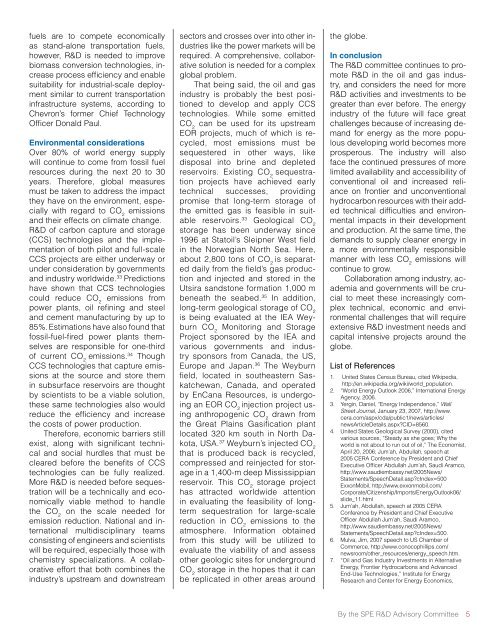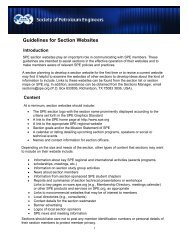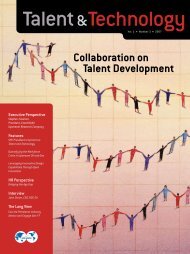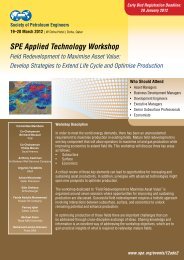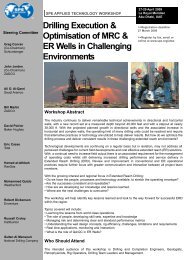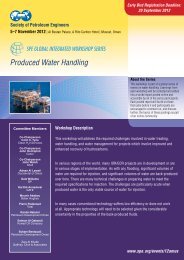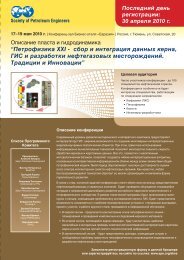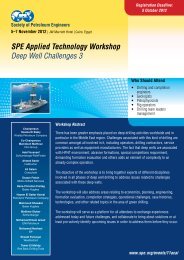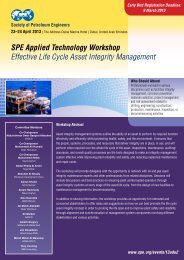The R&D Challenges to Secure Energy Supply for - Society of ...
The R&D Challenges to Secure Energy Supply for - Society of ...
The R&D Challenges to Secure Energy Supply for - Society of ...
You also want an ePaper? Increase the reach of your titles
YUMPU automatically turns print PDFs into web optimized ePapers that Google loves.
fuels are <strong>to</strong> compete economically<br />
as stand-alone transportation fuels,<br />
however, R&D is needed <strong>to</strong> improve<br />
biomass conversion technologies, increase<br />
process efficiency and enable<br />
suitability <strong>for</strong> industrial-scale deployment<br />
similar <strong>to</strong> current transportation<br />
infrastructure systems, according <strong>to</strong><br />
Chevron’s <strong>for</strong>mer Chief Technology<br />
Officer Donald Paul.<br />
Environmental considerations<br />
Over 80% <strong>of</strong> world energy supply<br />
will continue <strong>to</strong> come from fossil fuel<br />
resources during the next 20 <strong>to</strong> 30<br />
years. <strong>The</strong>re<strong>for</strong>e, global measures<br />
must be taken <strong>to</strong> address the impact<br />
they have on the environment, especially<br />
with regard <strong>to</strong> CO 2 emissions<br />
and their effects on climate change.<br />
R&D <strong>of</strong> carbon capture and s<strong>to</strong>rage<br />
(CCS) technologies and the implementation<br />
<strong>of</strong> both pilot and full-scale<br />
CCS projects are either underway or<br />
under consideration by governments<br />
and industry worldwide. 33 Predictions<br />
have shown that CCS technologies<br />
could reduce CO 2 emissions from<br />
power plants, oil refining and steel<br />
and cement manufacturing by up <strong>to</strong><br />
85%. Estimations have also found that<br />
fossil-fuel-fired power plants themselves<br />
are responsible <strong>for</strong> one-third<br />
<strong>of</strong> current CO 2 emissions. 34 Though<br />
CCS technologies that capture emissions<br />
at the source and s<strong>to</strong>re them<br />
in subsurface reservoirs are thought<br />
by scientists <strong>to</strong> be a viable solution,<br />
these same technologies also would<br />
reduce the efficiency and increase<br />
the costs <strong>of</strong> power production.<br />
<strong>The</strong>re<strong>for</strong>e, economic barriers still<br />
exist, along with significant technical<br />
and social hurdles that must be<br />
cleared be<strong>for</strong>e the benefits <strong>of</strong> CCS<br />
technologies can be fully realized.<br />
More R&D is needed be<strong>for</strong>e sequestration<br />
will be a technically and economically<br />
viable method <strong>to</strong> handle<br />
the CO 2 on the scale needed <strong>for</strong><br />
emission reduction. National and international<br />
multidisciplinary teams<br />
consisting <strong>of</strong> engineers and scientists<br />
will be required, especially those with<br />
chemistry specializations. A collaborative<br />
ef<strong>for</strong>t that both combines the<br />
industry’s upstream and downstream<br />
sec<strong>to</strong>rs and crosses over in<strong>to</strong> other industries<br />
like the power markets will be<br />
required. A comprehensive, collaborative<br />
solution is needed <strong>for</strong> a complex<br />
global problem.<br />
That being said, the oil and gas<br />
industry is probably the best positioned<br />
<strong>to</strong> develop and apply CCS<br />
technologies. While some emitted<br />
CO 2 can be used <strong>for</strong> its upstream<br />
EOR projects, much <strong>of</strong> which is recycled,<br />
most emissions must be<br />
sequestered in other ways, like<br />
disposal in<strong>to</strong> brine and depleted<br />
reservoirs. Existing CO 2 sequestration<br />
projects have achieved early<br />
technical successes, providing<br />
promise that long-term s<strong>to</strong>rage <strong>of</strong><br />
the emitted gas is feasible in suitable<br />
reservoirs. 33 Geological CO 2<br />
s<strong>to</strong>rage has been underway since<br />
996 at Sta<strong>to</strong>il’s Sleipner West field<br />
in the Norwegian North Sea. Here,<br />
about 2,800 <strong>to</strong>ns <strong>of</strong> CO 2 is separated<br />
daily from the field’s gas production<br />
and injected and s<strong>to</strong>red in the<br />
Utsira sands<strong>to</strong>ne <strong>for</strong>mation ,000 m<br />
beneath the seabed. 35 In addition,<br />
long-term geological s<strong>to</strong>rage <strong>of</strong> CO 2<br />
is being evaluated at the IEA Weyburn<br />
CO 2 Moni<strong>to</strong>ring and S<strong>to</strong>rage<br />
Project sponsored by the IEA and<br />
various governments and industry<br />
sponsors from Canada, the US,<br />
Europe and Japan. 36 <strong>The</strong> Weyburn<br />
field, located in southeastern Saskatchewan,<br />
Canada, and operated<br />
by EnCana Resources, is undergoing<br />
an EOR CO 2 injection project using<br />
anthropogenic CO 2 drawn from<br />
the Great Plains Gasification plant<br />
located 320 km south in North Dakota,<br />
USA. 37 Weyburn’s injected CO 2<br />
that is produced back is recycled,<br />
compressed and reinjected <strong>for</strong> s<strong>to</strong>rage<br />
in a ,400-m deep Mississippian<br />
reservoir. This CO 2 s<strong>to</strong>rage project<br />
has attracted worldwide attention<br />
in evaluating the feasibility <strong>of</strong> longterm<br />
sequestration <strong>for</strong> large-scale<br />
reduction in CO 2 emissions <strong>to</strong> the<br />
atmosphere. In<strong>for</strong>mation obtained<br />
from this study will be utilized <strong>to</strong><br />
evaluate the viability <strong>of</strong> and assess<br />
other geologic sites <strong>for</strong> underground<br />
CO 2 s<strong>to</strong>rage in the hopes that it can<br />
be replicated in other areas around<br />
the globe.<br />
In conclusion<br />
<strong>The</strong> R&D committee continues <strong>to</strong> promote<br />
R&D in the oil and gas industry,<br />
and considers the need <strong>for</strong> more<br />
R&D activities and investments <strong>to</strong> be<br />
greater than ever be<strong>for</strong>e. <strong>The</strong> energy<br />
industry <strong>of</strong> the future will face great<br />
challenges because <strong>of</strong> increasing demand<br />
<strong>for</strong> energy as the more populous<br />
developing world becomes more<br />
prosperous. <strong>The</strong> industry will also<br />
face the continued pressures <strong>of</strong> more<br />
limited availability and accessibility <strong>of</strong><br />
conventional oil and increased reliance<br />
on frontier and unconventional<br />
hydrocarbon resources with their added<br />
technical difficulties and environmental<br />
impacts in their development<br />
and production. At the same time, the<br />
demands <strong>to</strong> supply cleaner energy in<br />
a more environmentally responsible<br />
manner with less CO 2 emissions will<br />
continue <strong>to</strong> grow.<br />
Collaboration among industry, academia<br />
and governments will be crucial<br />
<strong>to</strong> meet these increasingly complex<br />
technical, economic and environmental<br />
challenges that will require<br />
extensive R&D investment needs and<br />
capital intensive projects around the<br />
globe.<br />
List <strong>of</strong> References<br />
. United States Census Bureau, cited Wikipedia,<br />
http://en.wikipedia.org/wiki/world_population.<br />
2. “World <strong>Energy</strong> Outlook 2006,” International <strong>Energy</strong><br />
Agency, 2006.<br />
3. Yergin, Daniel, “<strong>Energy</strong> Independence,” Wall<br />
Street Journal, January 23, 2007, http://www.<br />
cera.com/aspx/cda/public /news/articles/<br />
newsArticleDetails.aspx?CID=8560.<br />
4. United States Geological Survey (2000), cited<br />
various sources, “Steady as she goes; Why the<br />
world is not about <strong>to</strong> run out <strong>of</strong> oil,” <strong>The</strong> Economist,<br />
April 20, 2006; Jum’ah, Abdullah, speech at<br />
2005 CERA Conference by President and Chief<br />
Executive Officer Abdullah Jum’ah, Saudi Aramco,<br />
http://www.saudiembassy.net/2005News/<br />
Statements/SpeechDetail.asp?cIndex=500<br />
ExxonMobil, http://www.exxonmobil.com/<br />
Corporate/Citizenship/Imports/<strong>Energy</strong>Outlook06/<br />
slide_ .html<br />
5. Jum’ah, Abdullah, speech at 2005 CERA<br />
Conference by President and Chief Executive<br />
Officer Abdullah Jum’ah, Saudi Aramco,<br />
http://www.saudiembassy.net/2005News/<br />
Statements/SpeechDetail.asp?cIndex=500.<br />
6. Mulva, Jim, 2007 speech <strong>to</strong> US Chamber <strong>of</strong><br />
Commerce, http://www.conocophillips.com/<br />
newsroom/other_resources/energy_speech.htm.<br />
7. “Oil and Gas Industry Investments in Alternative<br />
<strong>Energy</strong>, Frontier Hydrocarbons and Advanced<br />
End-Use Technologies,” Institute <strong>for</strong> <strong>Energy</strong><br />
Research and Center <strong>for</strong> <strong>Energy</strong> Economics,<br />
By the SPE R&D Advisory Committee 5


